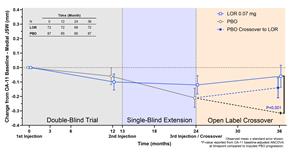Biosplice Therapeutics, Inc., a clinical-stage biotechnology company pioneering first-in-class therapeutics based on small-molecule inhibition of CLK/DYRK kinases, yesterday presented results from a long-term extension study, OA-07 for its knee OA drug candidate, lorecivivint.
Robust three-year X-ray results of medial joint space width (mJSW) and significant pain response in patients highlight the potential of lorecivivint to be a first-in-class, structure-modifying drug for the treatment of knee osteoarthritis (OA)
SAN DIEGO, Nov. 13, 2023 (GLOBE NEWSWIRE) -- Biosplice Therapeutics, Inc. (“Biosplice”), a clinical-stage biotechnology company pioneering first-in-class therapeutics based on small-molecule inhibition of CLK/DYRK kinases, yesterday presented results from a long-term extension study, OA-07 for its knee OA drug candidate, lorecivivint. The oral presentation was delivered in San Diego, California at the 2023 American College of Rheumatology (“ACR”) annual meeting. Results from the study support the potential for multiple injections of lorecivivint to delay structural progression and provide symptomatic benefit.
“We believe these unique data highlight lorecivivint’s potential to provide structural benefit and symptom relief to the millions of patients suffering from osteoarthritis,” commented Biosplice Chief Medical Officer, Yusuf Yazici, MD. “The full results from OA-07 build upon our existing evidence, suggesting that repeat injections of lorecivivint could provide patients and physicians with both structure-modifying and symptomatic benefits. We are excited to continue to investigate lorecivivint as a treatment option for knee OA.”
OA-07 was a long-term extension trial, which enrolled patients who completed OA-11, a prior 12-month Phase 3 study. The primary efficacy objective of OA-07 was to measure the structure improvement potential of lorecivivint over multiple years and multiple injections. During the first year of the OA-07 study, patients and investigators remained blinded, and patients received injections of lorecivivint on an annual basis, allowing Biosplice to capture both long-term and repeat-injection data for safety and efficacy, including pain, function, and structure.
In the second year of the OA-07 trial (which is the third year of the study, including the initial year from OA-11), placebo patients crossed-over to receiving lorecivivint, and all patients remained blinded as to whether they had previously received lorecivivint or placebo.
Patients who received three annual injections of lorecivivint and completed the study showed an absolute decline in mJSW of 0.06 mm versus baseline over 36 months. Patients receiving placebo injections after two years saw a decline of 0.21 mm, which is similar to average annual mJSW declines of 0.1-0.2 mm seen in population-wide studies of OA (Dupuis DE et al., Osteoarthritis and Cartilage, 2003). Comparing lorecivivint patients at 36 months to the last observation of placebo patients, a significant difference of 0.15 mm is seen (P=0.045). Assuming continued placebo progression from the last measurement point prior to crossover, consistent with longitudinal cohort studies of OA, the absolute difference between the active cohort and the placebo cohort is 0.26 mm, again a clinically and statistically significant result (P=0.001).
The structural benefits of lorecivivint were even more pronounced in patients with less severe disease (KL2 population), with an absolute increase in mJSW versus baseline of 0.17 mm following 36 months of treatment and statistically significant increase versus the last measurement point of placebo subjects prior to cross-over.
Furthermore, among those patients who previously had received placebo, the introduction of lorecivivint at month 24 appears to have arrested their decline in mJSW at 36 months.
Please see the graphic below for data amongst the population who completed the study.
| OA-11 and OA-07 “Completers” – Change from OA-11 Baseline in mJSW (mm) |
A graphic accompanying this announcement is available at https://www.globenewswire.com/NewsRoom/AttachmentNg/b9f9eb8d-1a80-4d17-964a-349f3fb955d6.
In addition to the exciting results in mJSW, the lorecivivint cohort demonstrated a statistically significant improvement in pain versus the placebo cohort prior to crossover.
Consistent with the clinical program to date, lorecivivint continued to appear safe and well-tolerated, with no additional safety signals with repeat injections.
A copy of the presentation materials can be seen on the Publications page of the Biosplice Therapeutics website.
About Biosplice
Biosplice is developing first-in-class, small-molecule therapeutics based on pioneering science of alternative pre-mRNA splicing. Stemming from foundational discoveries in Wnt pathway modulation, Biosplice has elucidated novel biology linking CLK/DYRK kinases to the therapeutic regulation of alternative splicing. Alternative splicing is an essential biological mechanism that regulates the diversification of proteins in a cell, which, in turn, determines cell type and function. Biosplice’s target class governs the selection of tissue-specific mRNA splice sites, making them attractive, druggable targets within the cellular “command and control” center.
Biosplice’s drugs in clinical development include lorecivivint for osteoarthritis (in Phase 3), cirtuvivint for numerous cancers, and a broad pipeline that ranges from Alzheimer’s disease to other degenerative conditions. Learn more at https://www.biosplice.com
Corporate Contact:
Erich Horsley
Biosplice Therapeutics, Inc.
erich.horsley@biosplice.com
858-365-0200






